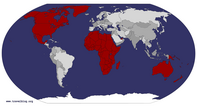Advertisement
Published: August 4th 2020

 Covid-19
Covid-19
Feeding schemes vital to avoiding starvation.It is mid-August 2025 as we sit around a roaring camp fire under a star lit night sky somewhere in the Central Kalahari Game Reserve chewing the fat on a wide range of topics. All eyes gaze intently at the bright, flickering flames of the fire providing a gentle orange glow and warmth against the evening chill. The conversation focuses on the superb animal and bird sightings of the day and we marvel at how the animal kingdom was left largely unscathed by the devastating Covid-19 pandemic. On the other hand, the impact on the World’s human population was catastrophic. Apart from the significant loss of human life, the economic implosion left many countries almost destitute, other diseases such as malaria and TB spiked significantly, non Covid-19 related deaths increased massively, starvation occurred in large swathes of Africa and India and worst of all, the virus has still not disappeared. Vaccines were found but it became necessary to receive the vaccine every year due to the virus taking on different genome sequencing which to this day has medical scientists baffled. But, despite the odds, humans have adapted

 Covid-19
Covid-19
Screen time statistics. Will where will usage be by end 2020?to a “new normal” and life goes on. The silence is broken by a question: “So, where did the coronavirus start and where did it come from?” No answer yet to this crucial question five years later but there have been many hypotheses.
The lingering view is that it started in a wet food market in
Wuhan,
China where a virus from an animal supposedly passed to a human being. Various animals were targeted, including pangolins, but bats were singled out as likely “culprits”. Wuhan had, prior to this virus emerging, built a massive medical laboratory whose main purpose was the study of all manner of animal viruses and their ability to jump across to humans. One of their principal medical scientists specialised in the study of bats in caves across many regions of China. Now to understand bats in China one needs to roll back the clock to the Mao Zedong era (1893-1976) which heralded the advent of Communism. To digress, for a short moment. Mao wanted China to become a major military power but the country lacked the type of heavy industry needed for the production of armaments. He turned to Russia who agreed to supply him

 Covid-19
Covid-19
The Hospitality Industry in deep trouble.with what he needed in exchange for food which was badly needed by the Russians. No problem for Mao. He simply instructed the Red Army to march across China annually and confiscate 90 percent of the peasant farmers production so that he could supply Russia. There were two major consequences; firstly, it is estimated that 75 million people died in China during Mao’s reign (mostly starvation) and secondly, many people in China had to scavenge and eat whatever they could find. This included bats which were generally boiled and then roasted. In essence the link with bats had gone back a long way and one can only wonder if all the viruses China has “gifted” the World don’t have some bat origin.
The conversation around the camp fire then drifted to the Chinese agreeing in 2022 to allow the World Health Organisation to visit their country and investigate the possible origins of the virus. But in typical covert behaviour, the WHO team were assigned and accompanied by Chinese medical “officials” who monitored and controlled every aspect of the investigation. Inevitable result, no conclusive evidence linking China to the origins of the virus ever emerged. Honesty simply did not exist.

 Covid-19
Covid-19
South Africa's wine industry in tatters. Protests make no difference to an ANC Govt hopelessly out of touch with economic reality.Back to the present. The
WHO numbers as of 3rd August reveal the following (
SA numbers in brackets);
17,981 million confirmed cases (511,485) and 686,703 deaths (8,366). We now rank fifth in the World in terms of infections. Each week now delivers a new set of nasty surprises;
Australia experiencing a significant outbreak in Melbourne, resulting in a strict lock down being imposed,
Vietnam, previously relatively unscathed, now reporting a large outbreak in one of their holiday towns resulting in the evacuation of 90,000 people to try and contain the virus, a resurgence of the virus in
Japan, South Korea and some of the major European countries.
America continues to see large daily infection increases in many states and there does not appear to be a cohesive script guiding a country wide response as various State Governors do “their own thing.” With autumn and winter looming in the Northern Hemisphere, there is serious concern about new waves of infection. The first stage human vaccine trials are underway and there are currently about 160 bio pharmaceutical companies engaged in a frantic race to find the silver bullet. The disastrous impact on global economies continues to unravel and the bounce back

 Covid-19
Covid-19
A street beggar desperate to survive.of global markets is being questioned with increasing comment of a major decline in markets likely.
Covid-19 has spawned a number of changes to our lifestyles which would have been previously unthinkable. One of them is screen time. In 2018 a study in the USA revealed that people there spent more than 12 hours a day looking at some form of screen; computers, e-readers, cell phones or television. Well, no surprise that there is even a new word for this problem by name of “Computer Vision Syndrome” (CVS). The culprit is blue light which is causing increasing numbers of people to visit ophthalmologists to deal with blurred vision and headaches. The real kicker is that the virus will have significantly increased most people’s time peering at a screen. Poor posture just adds to the CVS problem. So, what can we do to alleviate this problem likely to affect most people?
Some tips; (1) Have a good balance between the light from the display screen and your ambient light (2) Adjust the display on the screen to align resolution, brightness and contrast with ambient light (3) If you can, add a blue light filter (4) Pay attention to how you

 Covid-19
Covid-19
This cartoon sums up the feeding frenzy at the trough by so called political "leaders"sit; eyes should be about 3 feet away from the screen, the middle of the screen should be about 6 inches below eye level, proper posture with a supportive chair, the elbow joint should be about 90 degrees as you use the keyboard (5) Blink more. We tend to stare at a screen without blinking (6) Apply the “20-20-20” rule; every 20 minutes look at an object 20 feet away for at least 20 seconds (7) Get regular sunlight (Vitamin D) as it makes serotonin, our happiness brain chemical.
Another indisputable impact of Covid-19 is that the gap between the rich and the poor has widened significantly. Consider the white-collar working fraternity who have been able to largely work from home and not have to deal with the hazards of a daily commute and the associated virus dangers. In many cases no salary sacrifices have been suffered and with money in the bank, online deliveries have resulted in being able to ride out the virus in far greater comfort. Contrast that with the blue-collar working class. Many of their places of work shut down and many lost jobs or suffered wage cut backs. Meagre savings have been wiped out to simply ensure survival. With workplaces opening up, this class of worker has to undertake daily commutes with the cost and health factors thrown in. This is likely to fuel even further resentment and add to the existing platform of rioting and violence in evidence in America, in particular. Imagine the impact of a further hard lock down with lay offs and cutbacks. This could fuel revolutionary rioting on a scale never seen before. Let’s hope and pray this scenario does not unfold. These types of events balance on a knife edge as witnessed by the
#blacklivesmatter movement which morphed into a full-on attack on slavery and anything associated with it.
Here in sunny
South Africa there is never a dull moment. As many citizens feared, the moment a R500 billion Covid-19 “relief fund” was announced, so the rampaging thieves in Government lined up to see what they could steal. And boy, have they managed to steal! There is hardly a day go by without some breaking news about theft and corruption involving ANC leaders across the spectrum. Consider this; the President’s Spokesperson has just stepped down due to her and her husband being involved in some or other R125 million tender scandal. ANC Councillors in some towns grabbed food parcels, meant for the poor and destitute, for their own benefit. The real tragedy is that there is simply no consequence to this brazen theft and plunder. Those fingered simply “deny” or “blame” or claim “poor judgement, sorry”. And then to cap it all, our very own President Cyril Ramapromisa rattles on endlessly in a nauseating and parroting fashion, the same old message; “we condemn theft and the law will deal harshly with the perpetrators”. The reality is that on his watch, as President, there has not been a single arrest of an ANC politician or public servant implicated in a mind-boggling array of theft and corruption over the last ten years. We also conveniently choose to forget that this man sat alongside Zuma as Deputy President in the years of State Capture and did nothing and said nothing. The real tragedy of all this is that the poor folk in this country suffer the most at the hands of a political elite who have completely lost the plot. But, at long last, South Africans across the colour spectrum are stirring and there is a groundswell of anger and an increasing voice emerging that says “enough is enough.” Quo vadis?
“People’s indifference is the best breeding ground for corruption to grow.” – Delia Ferreira, chair of Transparency International.
Advertisement
Tot: 0.246s; Tpl: 0.018s; cc: 9; qc: 50; dbt: 0.0803s; 1; m:domysql w:travelblog (10.17.0.13); sld: 1;
; mem: 1.2mb










